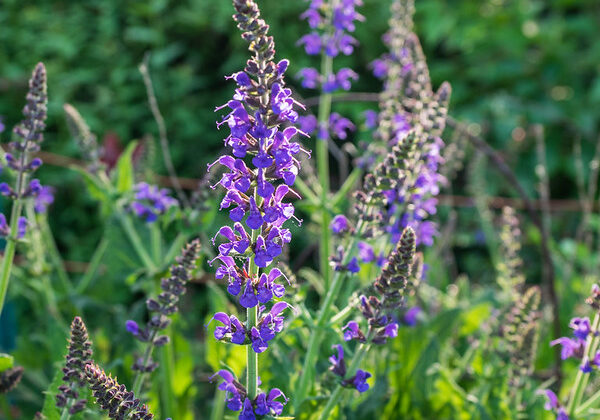
Fresh flowers of Salvia divinorum. Photo credit: F.D. Richards/flickr.
Salvia was largely unknown until, in 2010, when pop star Miley Cyrus appeared on video taking a bong rip of it. Though it was controversial at the time, the video brought interest to this particular plant.
The plant, which has deep purple blooms, commonly adorns gardens across America. But this eye-catching perennial herb is a potent hallucinogen.
Salvia, or Salvia divinorum, was previously thought to have no medical uses and is widely known for its recreational use. However, as researchers conduct more studies, they verified Salvia’s potential.
A study in the Journal of Ethnopharmacology examined Salvia’s active compounds by testing their properties as kappa opioid receptor (KOR) agonists on rats. To do so, researchers gave the rats a Salvia solution. Afterward, they compared their responses to carbamazepine, a nerve pain medication, and celecoxib, an anti-inflammatory. Results showed the rats experienced reduced neuropathic and inflammatory pain; they also illustrated Saliva’s viability as an alternative medication.
Despite it not being under the Controlled Substance Act, according to the Drug Enforcement Agency (DEA), it’s still controlled in some states.
One example is Wisconsin’s state Bill 186, which:
“[Prohibits] manufacturing, distributing, or delivering salvinorin A, a psychotropic ingredient in the plant Salvia divinorum, with the intent that it be consumed by a person. However, the prohibition does not apply to manufacturing a form of salvinorin A that is recognized by the U.S. Food and Drug Administration as a homeopathic drug and that may be obtained from a retail store without a prescription, or to distributing or delivering such a form of salvinorin A to a person who is 18 years of age or older.”
However, in states like Colorado or California, adults may purchase the plant itself fairly easily from nurseries or herb shops.
From Mexico to U.S. Gardens: the History of the Magic Mint
According to the American Addiction Centers (AAC), Salvia is a plant from the mint family. It originates from the Sierra Mazateca, a mountainous region in southern Mexico. The region’s natives, the Mazatec, originally used it as a medicinal herb and in ceremonial practices. Due to its hallucinogenic properties, many also use it as a recreational drug.
The Mazatec traditionally used Salvia for divination according to an article by the International Center for Ethnobotanical Education, Research, and Service (ICEERS). Healers and shamans were responsible for using Salvia for their folk medicine.
Based on the journal, Pharmaceuticals, the Mazatec people used salvia for ailments that ranged from headaches and joint pain to abdominal swelling or diarrhea. The journal also cites its use for insect bites and menstrual cramps.
In addition to this, shamans made use of Salvia’s hallucinogenic properties to induce visions in ceremonies.
Today, many gardeners grow the ‘magic mint’ in the U.S.
The entheogen can be used in a variety of ways, as listed on the National Institute on Drug Abuse (NIDA). One can chew on its leaves, ground it up to infuse it into a drink, or roll it up into cigarettes. Users can even vape it.
Like a “20 Minute Acid Trip”
Those who’ve tried Saliva describe it as intense. As VeryWellMind explained, “some people compare smoking salvia to “flipping a switch”—in a moment, everything turns from normal to an altered sense of reality and self-awareness. People often describe it as a “20-minute acid trip,” which can begin less than a minute after smoking the herb.”
One consumer, Daniel Oberhaus described his experience with it in Wired: “[…] I had felt my physical self disintegrate as a stunning diamond pattern began rolling from both sides of my face toward a boundless horizon. Any sense of self washed away and time became a meaningless abstraction. I was pure existence having an encounter with the infinite.”
Among its effects are out-of-body experiences or seeing extreme shapes, as described above, Healthline reports. Users may continue to feel a high from Salvia hours after its initial effects.
But Saliva also has therapeutic properties, which may help ease inflammation, to depression and digestive issues.
To analyze its effects on digestion, researchers from the journal Neurogastroenterology and Motility tested salvia divinorum extracts on healthy mice as well as those with small intestine inflammation. As the results showed, high dosages had an effect on the intestines of mice with inflammation. More specifically, their intestines returned to normal functionality after Salvia. These results demonstrate Salvia’s efficacy as a treatment for digestive disorders.
Research also shows it may be helpful at combating mental health conditions. In one case study of a 26-year old woman, in the Journal of Clinical Psychopharmacology, researchers gave half to three-fourths of a gram of Salvia leaves to the patient three times a week over the course of six months. The patient had previously experienced depressive symptoms. After six months, she had drastic improvements in these symptoms.
Legality of Salvia
Based on an article by Dr. Ahmed Zayed in the Addiction Resource center, there has been much conflict on the legal status of Salvia. While it’s legal in some states or countries, others — like the UK and Australia — have banned it. States may also have differing laws on its production, usage, or sale.
On one hand, the states Missouri, Louisiana, and Delaware have placed Salvia under schedule I drug classification. On the other hand, states such as Alaska or Colorado, have declared it legal. California, however, makes it legal to those over 18.
While the Mazatec culture used Salvia as a natural remedy, officials have yet to approve it for medical use in the U.S. But, as scientists investigate Salvia’s medical potential more, we may see restrictions lift in these states and countries.


Leave a Reply